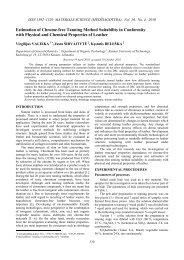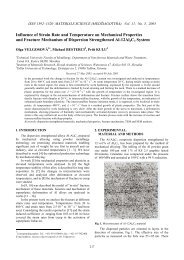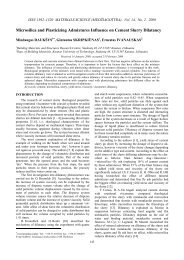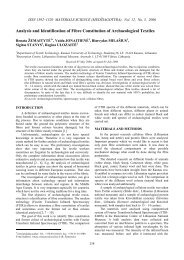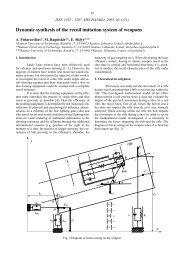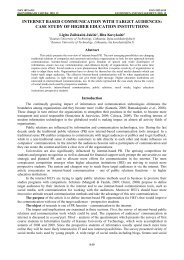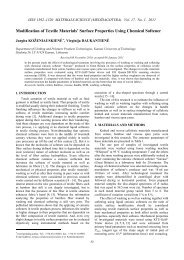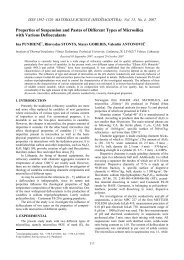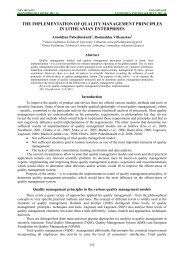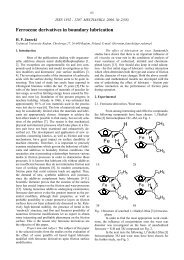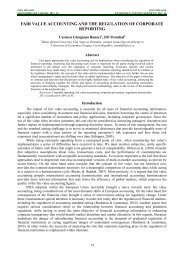issn 1392–1320 materials science \(medžiagotyra\) - Kaunas
issn 1392–1320 materials science \(medžiagotyra\) - Kaunas
issn 1392–1320 materials science \(medžiagotyra\) - Kaunas
You also want an ePaper? Increase the reach of your titles
YUMPU automatically turns print PDFs into web optimized ePapers that Google loves.
ISSN <strong>1392–1320</strong> MATERIALS SCIENCE (MEDŽIAGOTYRA). Vol. 9, No. 4. 2003<br />
Dependence of Air Permeability on Various Integrated Fabric Firmness Factors<br />
A. Olšauskienė ∗ , R. Milašius<br />
Department of Textile Technology, <strong>Kaunas</strong> University of Technology, Studentų 56, LT-3031 <strong>Kaunas</strong>, Lithuania<br />
Received 30 September 2003; accepted 24 October 2003<br />
The present article deals with the dependence of air permeability of technical assignment fabrics on various<br />
parameters of fabric structure. It has been established that although fabric air permeability depends on weft density and<br />
weave factor P1, however, it is possible to achieve the same air permeability of different weaving fabrics if to calculate<br />
weft densities S 2 for each weaving when ϕ = const. It means that it is possible to design a corresponding air permeability<br />
fabric according to the fabric firmness factor ϕ.<br />
The article presents a number of factors of various fabric structure (Milašius, Brierley, Galuszyski, Galceran) and in<br />
this respect fabric air permeability to be compared. It has been established that the structure factor ϕ proposed by<br />
Milašius evaluates all the weaves except weft rips 2/2 best and should be used for designing a fabric according to<br />
necessary air permeability.<br />
Keywords: air permeability, fabric structure parameters.<br />
1. INTRODUCTION ∗ According to Galceran [6] the fabric tightness O can<br />
be calculated by following equation:<br />
The air permeability of fabric is one of very important<br />
properties of technical fabrics. The air permeability<br />
depends on shape and value of the pores and the interthread<br />
channels, which are dependent on the structural<br />
parameters of the fabric [1, 2]. The main structural<br />
parameters, which have influence on fabric air<br />
permeability, are set and linear densities of yarns and<br />
weave.<br />
Early it was established air permeability dependences<br />
on weave and set of yarns particularly [3]. Designing<br />
fabrics and their technological parameters and analysing<br />
their properties we are constantly in contact with a problem<br />
how to generalize fabric structure properties by one<br />
integrating factor. Peirce [4] particularly precisely<br />
disclosed the meaning of integrating fabric structure factor:<br />
“It … gives a very suitable basis of comparison for any<br />
experimental investigation, not only of cover but also of<br />
hardness, crimp, permeability and transparency, limits of<br />
picking, etc., in which fabrics of similar cover factors show<br />
similarity.”<br />
The integrating fabric structure factors can be<br />
distributed into two groups: referring to Peirce’s [4] theory<br />
and referring to Brierley’s [5] theory of maximum setting.<br />
Whatever fabric structure factor is it is always calculated<br />
comparing a certain mathematical expression of<br />
parameters of the given fabric structure with maximum<br />
value of so called standard fabric. In the first case it is the<br />
ratio of the area covered by one or two yarn systems with<br />
the whole area of fabric (it is a meaning of all fabric<br />
firmness factors). There are several integrating structure<br />
factors corresponding to Peirce theory, namely: Galceran<br />
[6], Seyam and El-Shiekh [7], Newton [8]. However, here<br />
we are going to analyse more widely only Galceran factor<br />
because it evaluates the fabric structure from this group of<br />
factors best [9].<br />
∗ Coresponding author. Tel.: + 370-37-307293.; fax: + 370-37-353989.<br />
E-mail address: mindas@elektrobalt.lt (A. Olšauskienė)<br />
401<br />
O =<br />
5<br />
S1<br />
T1<br />
S 2 T2<br />
+<br />
1000 1000<br />
πρ<br />
1<br />
1+<br />
0.<br />
73Kl<br />
1<br />
5 πρ 2<br />
+<br />
1+<br />
0.<br />
73Kl<br />
2<br />
100<br />
; (1)<br />
here: S1/2 is the set of the warp and weft, respectively, T1/2<br />
is the linear density of the warp and weft, ρ1/2 is the warp<br />
and weft fiber density, Kl1/2 is the weave factors.<br />
The precision explaining of this and other equations it<br />
is possible to found in presented references.<br />
In the Brierley’s case fabric structure factor is the ratio<br />
of set of the given fabric “square” (balanced) structure<br />
analogue with the set of the standard “wire” plain weave<br />
fabric [5]. The original Breirley’s factor called him as<br />
Maximum Setting / Maximum Density can be calculated by<br />
following equation:<br />
12 1 T<br />
1 g T1<br />
/ T2<br />
T<br />
m<br />
2<br />
1<br />
average 1+<br />
g T1<br />
/ T2<br />
1+<br />
g T1<br />
/ 2<br />
[ MS / MD]<br />
=<br />
S S<br />
π F<br />
ρ<br />
; (2)<br />
here: F m is the empirical weave factor, g = 2/3, if F1 ≥ F2,<br />
and g = 3/2, if F1 < F2 (excepting weft faced ribs, in this<br />
case g = 2), S1/2, T1/2 and ρ – as in eq. (1)<br />
Galuszinski [10] analysing weaving resistance found<br />
that Brierley’s formula “requires some modification of<br />
certain values of the coefficients m and g for some weft-<br />
and warp-faced ribs” and proposed the coefficient of fabric<br />
tightness TGaluszinski. For the weft-faced ribs value F is taken<br />
as an average for the weave with g = 2/3 (whereas Brierley<br />
suggested that value of F has to be taken as an average<br />
for the warp threads and g should be equal to 2). For warpfaced<br />
ribs Galuszinski proposed the value of m = 0.35<br />
instead of 0.42 given by Brierley.<br />
Milašius [11 – 13] proposed new integrating fabric<br />
firmness factor that can be calculated by equation:
1 2 / 3 T1<br />
/ T2<br />
12 1 Taverage<br />
1+<br />
2 / 3 T1<br />
/ T2<br />
1+<br />
2 / 3 T1<br />
/ T2<br />
ϕ =<br />
S2<br />
S1<br />
; (3)<br />
π P1<br />
ρ<br />
here: P1 is the weave factor, S1/2, T1/2 and ρ – as in eq. (1)<br />
The two main differences from Brierley’s proposals<br />
are – firstly, in equation (3) only factor’s g value equal to<br />
2/3 is used (and above all it is independent from the type of<br />
the weave). Secondly – the new weave factor P calculated<br />
directly from the weave matrix [11] is used. It has no<br />
relation with cloth setting and the linear density of threads.<br />
The firmness factor ϕ also can be used for fabric<br />
properties prediction, for example, air permeability of<br />
fabric depends on threads set as well as on weave [14].<br />
The goal of presented investigations is to show a<br />
possibility of air permeability designing by integrated<br />
firmness factor ϕ and to compare a various integrated<br />
firmness factors in respect of air permeability.<br />
2. EXPERIMENTAL RESULTS AND<br />
DISCUSSIONS<br />
Experimental investigations establishing the dependence<br />
of fabric air permeability on their weft density were<br />
carried out with 8 fabrics of different weavings, namely:<br />
plain, twill 2/2, warp rib 2/2, weft rib 2/2, 8 healds sateen,<br />
basket weave 4/4, twill 4/4 and rib-basket weave 2/4. All<br />
these fabrics were woven on the STB projectile weaving<br />
loom from polyester yarns 29.4 tex when the warp set<br />
S1 = 284 dm –1 . Fabric air permeability was established<br />
according to LST EN ISO 9237:1997 standard [15].<br />
According to this standard air permeability is the air yield<br />
passed through a definite area of a fabric during a<br />
specified period of time with the pressure difference of<br />
50 Pa (the instrument VPTM – 2M).<br />
The air permeability of fabrics depends on a number of<br />
Q, dm 3 /(m 2 s)<br />
1400<br />
1300<br />
1200<br />
1100<br />
1000<br />
900<br />
800<br />
700<br />
600<br />
500<br />
400<br />
300<br />
200<br />
100<br />
0<br />
factors, one of them being thread set of fabrics. Fig. 1<br />
presents fabric air permeability Q of various weavings of<br />
polyester fabrics on the set of weft S2 (the coefficients of<br />
variation of all experimental points do not exceed 10 %).<br />
Fig. 1 presents 8 different weavings having the same<br />
integrated firmness factor ϕ (ϕ = 71.5 %), and air<br />
permeability dependence on weft set (series 1). The stable<br />
ϕ is hold by changing weft set S2 when warp set<br />
S1 = 284 dm –1 . So, we see that fabric air permeability of<br />
different weavings changes slightly.<br />
The other curves (series 2 – 9) present air permeability<br />
dependences of individual weaves on weft set S2 (in this<br />
case, too, S1 = 284 dm –1 , however, ϕ = const). From these<br />
curves we can see that when weft set increases provided<br />
warp set is stable, fabric air permeability decreases.<br />
If we choose S2 for each weaving securing ϕ stability,<br />
air permeability changes slightly (series 1), the coefficient<br />
of determination of the straight line of series 1 being<br />
negligible R1 2 = 0.0571. So we can state that according to<br />
the formula (4) having calculated S2 (provided ϕ = const)<br />
for each weaving it is possible to achieve the same air<br />
permeability for different weaving fabrics.<br />
Fig. 2 presents air permeability dependences on the<br />
weave factor for fabrics made of multifilament 29.4 tex<br />
polyester yarns both in warp and in weft. The fabrics were<br />
manufactured in four series with the same set of warp<br />
(S1 = 284 dm –1 and, series 1 – with the same set of weft<br />
S2 = 230 dm –1 , series 2, series 3 and series 4 – with the<br />
same firmness factor ϕ (ϕ = 53.1 %, ϕ = 61.5 % and<br />
ϕ = 71.5 %).<br />
As can be seen in Fig. 2 air permeability dependence<br />
on the weave factor when the sets of weft and warp are<br />
constant can be described by the second order equation<br />
with a rather high coefficient of determination, which show<br />
a regressive equation correspondence to experimental<br />
2<br />
R1 = 0.0571<br />
100 150 200 250 300 350 400 450 500 550 600 650 700 750<br />
Fig. 1. Dependence of fabric air permeability Q on weft set S 2<br />
402<br />
S 2, dm -1<br />
series 1 - for all weaves, when<br />
φ=const=71,5 %<br />
series 2 - plain<br />
series 3 - warp rib 2/2<br />
series 4 - twill 2/2<br />
series 5 - weft rib 2/2<br />
series 6 - 8 healds sateen<br />
series 7 - basket weave 4/4<br />
series 8 - twill 4/4<br />
series 9 - rib - basket weave 2/4<br />
Linear (series 1 - for all weaves, when<br />
φ=const=71,5 %)
Q, dm 3 /(m 2 s)<br />
800<br />
700<br />
600<br />
500<br />
400<br />
300<br />
200<br />
100<br />
0<br />
2 2<br />
R1 = 0.8014 R2 = 0.2297<br />
2 2<br />
R3 = 0.0966 R4 = 0.0303<br />
Series1<br />
Series2<br />
Series3<br />
Series4<br />
1 1,2 1,4 1,6 1,8 2<br />
Fig. 2. Dependence of fabric air permeability Q on weave factor<br />
P1: 1 – S 1 = const (284 dm –1 ), S 2 = const (230 dm –1 ),<br />
2, 3 and 4 – ϕ = const (2 – 53.1 %, 3 – 61.5 % and<br />
4 – 71.5 %).<br />
values (R1 2 = 0.8014). Meanwhile when the factor ϕ is<br />
constant the dependence of fabric air permeability on the<br />
weave factor P1 is very low (R 2 = 0.0303 ÷ 0.2297). So we<br />
may state that air permeability Q does not depend on the<br />
fabric weave factor P1, if the integral filling factor ϕ is<br />
constant.<br />
Although air permeability strongly depends on both<br />
thread density and weaving, however, air permeability<br />
dependences on S2 and P1 (on fabrics woven by these<br />
different parameters but having the same ϕ) are negligible.<br />
It means that it is possible to design a fabric of suitable air<br />
permeability according to the fabric firmness factor ϕ.<br />
When experimenting we used structure factors offered<br />
by Milašius, Brierley, Galuszynski and Galceran because<br />
as it has been established earlier they evaluate the structure<br />
of a fabric best [9]. The drawback of the fabric structure<br />
factor MS/MD offered by Brierley is that the weave factor<br />
F m is empirical and m depends on a weave type and can be<br />
obtained only experimentally. So we declined the rib –<br />
weave 2/4 weaving fabric because this empirical factor for<br />
this weaving is unknown (Brierley has not established it).<br />
Since as it can be seen in Fig. 2 in this case when<br />
ϕ = const, the dependence of air permeability on the weave<br />
factor P1 changes slightly, so later we did not draw a<br />
straight line equation, but a mean value line.<br />
A plain fabric was chosen as an indication point<br />
calculating various fabric structure factors (Milašius,<br />
Brierley, Galuszynski and Galceran) provided<br />
S1 = 284dm –1 and. S2 = 180 dm –1 . According to the<br />
calculated structure factor the sets of other weaves wefts<br />
were determined keeping up the constant warp set<br />
(S1 = 284 dm –1 ).<br />
The fabric structure factor value proposed by Galceran<br />
differs from the other proposed factors because this factor<br />
was calculated according to the formula (1), which differs<br />
P 1<br />
403<br />
virtually from the calculation formulas of the other<br />
structure factors (Milašius, Brierley, Galuszynski).<br />
Q, dm 3 /(m 2 s)<br />
Q, dm 3 /(m 2 s)<br />
Q, dm 3 /(m 2 s)<br />
Q, dm 3 /(m 2 s)<br />
200<br />
150<br />
100<br />
50<br />
0<br />
150<br />
100<br />
50<br />
0<br />
200<br />
150<br />
100<br />
50<br />
0<br />
250<br />
200<br />
150<br />
100<br />
50<br />
0<br />
Q = 84.3<br />
1 1,2 1,4 1,6 1,8 2<br />
a<br />
P 1<br />
Q = 71.4<br />
1 1,2 1,4 1,6 1,8 2<br />
b<br />
P 1<br />
Q = 87.5<br />
1 1,2 1,4 1,6 1,8 2<br />
c<br />
P 1<br />
Q = 92<br />
1 1,2 1,4 1,6 1,8 2<br />
d<br />
Fig. 3. Dependence of fabric air permeability Q on weave factor<br />
P 1 at constant fabric structure factors: a) ϕ = 61.6;<br />
b) MS/MD = 61.6; c) TGaluszynski = 61.6; d) O Galceran = 66.1<br />
As can be seen in Fig. 3 in all these cases (a) ϕ =const;<br />
b) MS/MD = const; c) TGaluszynski = const; d) OGalceran = const)<br />
P 1
point dispersal is similar. However, if in Milašius (a) and<br />
Galuszynski (c) cases the greatest deviation from the mean<br />
value is obtained in the case of weft rib 2/2 (P1 = 1,<br />
Q = 199.8 dm 3 /(m 2 s) and P1 = 1, Q = 185.6 dm 3 /(m 2 s)),<br />
that in the case of Galceran (d) the greatest noncorrespondence<br />
to the mean value is obtained to the weaves<br />
the both systems of which are woven by long floats and the<br />
weave factor of which is P1 = 1.7 ÷ 1.9.<br />
The smallest air permeability dispersal is in the case of<br />
Brierley, however, according to Brierley and Galuszynski<br />
proposed structure factors we cannot evaluate those<br />
weaves as the empirical factor m is unknown (in our case<br />
such a weave was rib basket weave 2/4) and it is an<br />
essential drawback of these factors.<br />
The fabric structure factor suggested by Milašius can<br />
evaluate all weaves, however, in the case of weft ribs 2/2<br />
the value of air permeability in this point differed distinctly<br />
from the mean air permeability value of all weaves. This<br />
cannot be noticed both in the case of Galceran (P1 = 1,<br />
Q = 101.8) and Brierley (P1 = 1, Q = 101.8).<br />
However, in the case of Galceran the weaves of which<br />
are P1 > 1.7 are evaluated bad. So, it is possible to affirm<br />
that the structure factor ϕ proposed by Milašius evaluates<br />
all the analyzed fabric structure factors best except weft<br />
ribs 2/2. So, while designing a fabric according to a<br />
necessary air permeability it should be used this criterion<br />
best except the weft rib 2/2 case when it is expedient to use<br />
Brierley or Galceran criterion.<br />
3. CONCLUSIONS<br />
The investigation of the fabrics woven by various<br />
weaves (plain, twill 2/2, warp rib 2/2, weft rib 2/2, 8 healds<br />
sateen, basket weave 4/4, twill 4/4 and rib-basket weave<br />
2/4) of polyester multifilament 29.4 tex yarns was carried<br />
out.<br />
It has been determined by experiments that although<br />
fabric air permeability depends on the weft set and weave<br />
factor P1 and having calculated weft set S2 for each weave<br />
when ϕ = const it is possible to achieve the same air<br />
permeability for fabrics of different weaves, i.e. in this<br />
case when the integrated structure factor ϕ is constant, the<br />
influence of weft set and fabric weave factor on air<br />
permeability is very low. It means that it is possible to<br />
design a fabric conformable to air permeability according<br />
to the fabric firmness factor ϕ.<br />
Out of fabric structure factors (Milašius, Brierley,<br />
Galuszynski and Galceran) the structure factor ϕ suggested<br />
by Milašius evaluates all the weaves except weft ribs 2/2<br />
best, therefore while designing a fabric according to the<br />
necessary air permeability this criterion should be used<br />
404<br />
best (except the case of weft ribs 2/2, when it is expedient<br />
to use either Brierley or Galceran criterion).<br />
REFERENCES<br />
1. Szosland, J. Identification of Structure of Inter-Thread<br />
Channels in Models of Woven Fabrics Fibres & Textiles in<br />
Eastern Europe 7 (2) 1999: pp. 41 – 45.<br />
2. Olšauskienė, A., Milašius, R. Influence of Fabric Structure<br />
on Air Permeability Proceedings of International<br />
Conference “The Textiles: Research in Design and<br />
Technology”, <strong>Kaunas</strong>: Technologija, 2000: pp. 201 – 206.<br />
3. Milašius, V., Milašius, R., Kumpikaitė, E., Olšauskienė,<br />
A. Influence of Fabric Structure on Some Technological and<br />
End-use Properties Fibres & Textiles in Eastern Europe<br />
11 (2) 2003: pp. 49 – 52.<br />
4. Peirce, F. T. The Geometry of Cloth Structure J. Text. Inst.<br />
28 1937: T45 – 196.<br />
5. Brierley, S. Cloth Settings Reconsidered The Textile<br />
Manuf. 79 1952: pp. 349 – 351, 533 – 537, 595 – 597.<br />
6. Galceran, V. Tecnologia del Tejido, Terrasa, 1961<br />
(in Spanish).<br />
7. Seyam, A., Aly El-Shiekh. Mechanics of Woven Fabrics.<br />
Part IV: Critical Review of Fabric Degree of Fabric<br />
Tightness and Its Applications Text. Res. J. 64 1994:<br />
pp. 653 – 662.<br />
8. Newton, A. The Comparison of Woven Fabrics by<br />
Reference to Their Tightness J. Text. Inst. 86 1995:<br />
pp. 232 – 240.<br />
9. Milašius, R., Milašius, V., Kumpikaite, E., Olšauskienė,<br />
A. Development of Employment of Fabric Firmness Factor<br />
ϕ VII International Conference ArchTex, Poland, Lodz,<br />
2003: pp. 149 – 154.<br />
10. Galuszinski, S. Fabric Tightness: A Coefficient to Indicate<br />
Fabric Structure J. Text. Inst. 72 1981: pp. 44 – 49.<br />
11. Milašius, V. An Integrated Structure Factor for Woven<br />
Fabrics, Part I: Estimation of the Weave J. Text. Inst.<br />
91 (2) 2000: pp. 268 – 276.<br />
12. Milašius, V. An Integrated Structure Factor for Woven<br />
Fabrics, Part II: Fabric-firmness Factor J. Text. Inst. 91 (2)<br />
2000: pp. 277 – 284.<br />
13. Milašius, V., Milašius, A., Milašius, R. Comparison of<br />
Integrating Structure Factors of Woven Fabric Materials<br />
Science (Medžiagotyra) 9(1) 2001: pp. 48 – 53.<br />
14. Olšauskienė, A., Milašius, R. Dependence of Air<br />
Permeability on Fabric Porosity and Integrated Fabric<br />
Firmness Factor ϕ Materials Science (Medžiagotyra)<br />
9 (1) 2003: pp. 124 – 127.<br />
15. LST EN ISO 9237:1997 Textiles – Determination of<br />
Permeability of Fabrics to Air, 1997 (in Lithuanian).



